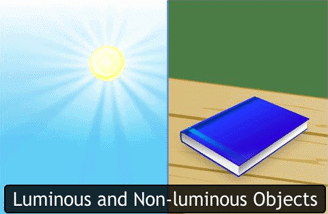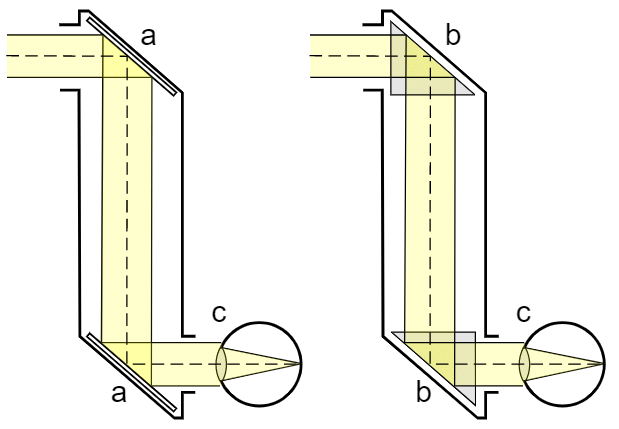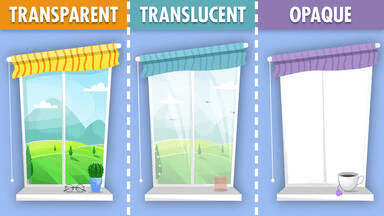Class 6 Science Chapter 8 Question Answers - Light, Shadow and Reflections
Short Answer Type Questions
Q1: What is the difference between transparent and translucent object?
Ans: If we are able to see clearly through an object, it is said to be transparent. Whereas there are some objects through which we can see but not clearly. Such objects are known as translucent objects.
Transparent objects allows light to pass through them completely whereas translucent objects doesn’t allow light to pass through them completely.
Q2: What materials can be used to make a pinhole camera? How can it be used?
Ans: Pinhole camera can be made with simple material like cardboard, tracing paper etc. It can be used to image the sun and brightly lit objects.
 Pinhole Camera
Pinhole Camera
Q3: Why is shadow formed when an opaque object comes in path of light?
Ans: Light travels in a straight line and when opaque object obstructs it, shadow is formed.
Q4: What is reflection?
Ans: When any surface reflects light without absorbing it, it is known as reflection.
Q5: Classify the objects as opaque, transparent and translucent- Fog, glass, wood, plastic box, smoke, water.
Ans: Transparent-glass and water.
Opaque-wood and plastic box
Translucent- fog and smoke
Q6: Why we cannot see our image in the mirror in complete dark room?
Ans: We cannot see our image in the mirror in complete dark room because there is no light to reflect.
Q7: Classify the following as luminous and non luminous object: Sun, moon, table, chair, stars.
Ans: Luminous –sun, stars
Non luminous-moon, table, chair
Q8: What is the difference between luminous and non luminous objects?
Ans: Objects that give out or emit light of their own are known as luminous objects. For example candle, sun etc. Objects that cannot give out or emit light of their own are known as non- luminous objects. Such as chair, book etc.

Q9: Why we cannot see objects through T shaped or N shaped pipe?
Ans: We cannot see objects through T shaped or N shaped pipe because light travels through straight line.
Q10: What do we need to see an object?
Ans: To see an object, we need source of light, eyes and object. When light emitted by luminous body falls on an object, it is reflected back and received by our eyes. Then we see that object.
Q11: Give example of an object which is a) opaque and luminous b) translucent and luminous.
Ans:
A) Sun
b) flame of gas burner.
Q12: If moon is non luminous, how it appears bright in night?
Ans: Moon appears bright in night because it reflects sun light that falls on it.
Q13: What type of objects does not cast shadow and why is that?
Ans: Transparent and some translucent objects do not cast shadow because light passes through them.
Q14: Why polished surface cause glares in our eyes?
Ans: Polished surface cause glares in our eyes because they produce regular reflection of light.
Q15: Give two examples of each:
a) Transparent and non luminous object.
b) Translucent and non luminous object.
Ans:
a) Air and water
b) polythene and smoke.
Q16: Which of these object can cast shadow: Paper, air, rock, glass, sun
Ans: Paper, rock and sun.
Q17: How is shadow formed?
Ans: When an object is placed in path of light, a dark portion is formed on the opposite side of object. This dark portion is shadow.
Q18: What is periscope?
Ans: Optical object by which we can see objects located above our line of sight.
 Periscope
Periscope
Long Answer Type Questions
Q1: Why can we see our image in the mirror?
Ans: Light rays reflected from parts of our body fall on mirror and are reflected back. When these reflected rays reach our eyes (reflected on our retina), we can see the image. Mirror has one surface painted so when we see the mirror light rays which reflect from our body not get pass through mirror.
Q2: What are transparent, translucent and opaque objects? Explain with example.
Ans: If we are able to see clearly through an object, it is said to be transparent. Example-Glass and water. There are some objects through which we can see but not clearly. Such objects are known as translucent objects. Example- tracing paper. If we cannot see through an object at all, it is an opaque object. Example -wood, plastic box etc.

FAQs on Class 6 Science Chapter 8 Question Answers - Light, Shadow and Reflections
| 1. What is light? |  |
| 2. How are shadows formed? |  |
| 3. What is the difference between reflection and refraction? |  |
| 4. How do mirrors work? |  |
| 5. How does a prism separate white light into different colors? |  |

















